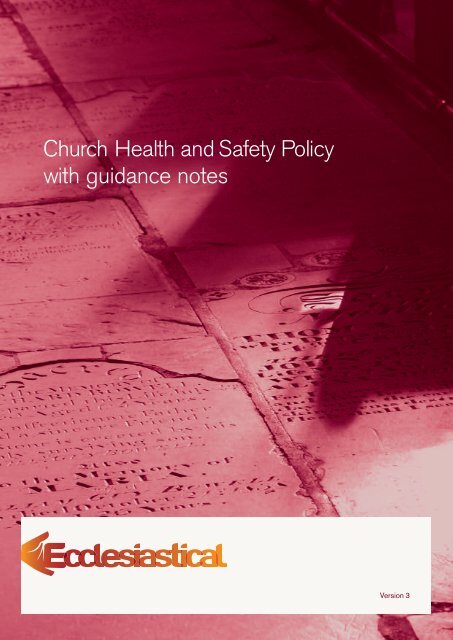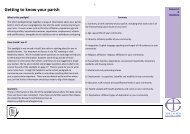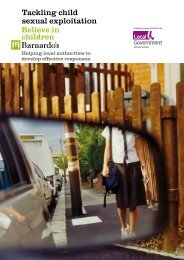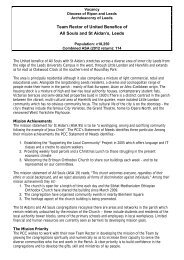Church Health & Safety Policy with guidance notes - Ecclesiastical ...
Church Health & Safety Policy with guidance notes - Ecclesiastical ...
Church Health & Safety Policy with guidance notes - Ecclesiastical ...
- No tags were found...
You also want an ePaper? Increase the reach of your titles
YUMPU automatically turns print PDFs into web optimized ePapers that Google loves.
<strong>Church</strong> <strong>Health</strong> and <strong>Safety</strong> <strong>Policy</strong><strong>with</strong> <strong>guidance</strong> <strong>notes</strong>Version 3
Contents<strong>Policy</strong>Introduction 3Our <strong>Health</strong> and <strong>Safety</strong> <strong>Policy</strong> 4Section A – General statement of policy 5Section B – Organisation and responsibilities 6Section C – Arrangements (implementation of the policy) 10– Accidents and first aid 10– Fire safety 11– Electrical safety 13– Gas equipment safety 14– Hazardous substances 14– <strong>Safety</strong> of plant and machinery 14– Slips, trips and falls 15– Lighting 16– Working at high levels 16– Preparation of food 16– Manual handling – lifting, carrying and moving loads 16– Display screen equipment 17– Hazardous buildings/glazing 17– Child protection 17– Personal safety 17– Risk assessments/activities 18– Contractors 18– Information and enforcement 19– <strong>Health</strong> and <strong>Safety</strong> law poster 19Guidance <strong>notes</strong><strong>Health</strong> and safety <strong>guidance</strong> <strong>notes</strong> 21The following <strong>guidance</strong> <strong>notes</strong> are also available fromyour Insurance Consultant and Surveyor, by calling ourDirect Commercial Department on 0845 777 3322 orby visiting our website at www.ecclesiastical.comFireSecurity<strong>Health</strong> and <strong>Safety</strong>FunctionsThese <strong>guidance</strong> <strong>notes</strong> are based on currentlegislation and we have tried to make themthorough and informative. If you require anyfurther assistance, please contact the relevantorganisations mentioned in the <strong>notes</strong>.This advice is given in good faith and isbased on our understanding of current lawand practice. Neither <strong>Ecclesiastical</strong>, nor itssubsidiaries accept any liability whatsoeverfor any errors or omissions which may resultin injury, loss or damage, including consequentialor financial loss. It is the responsibility of theInsured or any other person to ensure that theycomply <strong>with</strong> their legal responsibilities and anyinterpretation or implementation of this <strong>guidance</strong>is at the sole discretion of the Insured or otherparty who may read these <strong>notes</strong>.
CHURCH – HEALTH AND SAFETY POLICY & GUIDANCE NOTES 3This document has been produced by<strong>Ecclesiastical</strong> to help you draw up yourown <strong>Health</strong> and <strong>Safety</strong> <strong>Policy</strong><strong>Church</strong>es are not exempt from health and safetylegislation. Local Authority Environmental <strong>Health</strong>Officers are specifically charged <strong>with</strong> enforcinghealth and safety legislation in churches.The <strong>Health</strong> and <strong>Safety</strong> Executive haveadvised that it is good practice for volunteersto be provided <strong>with</strong> the same level of healthand safety training and protection as if theywere employees. This means that churchesshould follow exactly the same regulations toensure the health and safety of volunteersand other persons using the church as ifthey were employees.Following the enclosed <strong>guidance</strong> will help toensure that you will have done all you needin order to satisfy the Environmental <strong>Health</strong>Officer should one call.We would suggest that you appoint someone<strong>with</strong> responsibility for health and safety, andpossibly set up a sub-committee under the<strong>guidance</strong> of the Parochial <strong>Church</strong> Council.Then work through the outline health andsafety policy. Remember, this document isintended as a guide only. It is your policy. Youwill need to insert the details applicable toyour own church, delete parts that are notapplicable, and amend or add others.What does the law require?The law only requires those who employ fiveor more people to have a written health andsafety policy. This will not apply to the majorityof churches. However, you are required tomake adequate arrangements for health andsafety, and the easiest way to do this is to setthese out in writing.For every hazardous activity you undertake,you should have a written procedure.Remember the <strong>Health</strong> and <strong>Safety</strong> Executivesays that measures need only be matchedto the levels of risk. It may only be possibleto decide on your procedures once you havecarried out a risk assessment.The law only requires written risk assessmentswhere five or more people are employed,and then only the significant findings have tobe recorded.However, you need to ensure that your churchis safe, and the easiest way to do this is tocarry out systematic risk assessments of eachpart of the church and each activity.To help you do this, <strong>guidance</strong> is given on howto undertake risk assessments and how torecord them.A general risk assessment pro-forma isenclosed. Copy this form as often as you need.Further help and informationA number of detailed <strong>guidance</strong> <strong>notes</strong> arealso available from <strong>Ecclesiastical</strong>. Theseare available from your Insurance Consultantand Surveyor, by calling our Direct CommercialDepartment on: 0845 777 3322 or on ourwebsite www.ecclesiastical.comIf you have any queries at all, pleasecontact us or your local <strong>Ecclesiastical</strong>Insurance Consultant and Surveyor forhelp and <strong>guidance</strong>.
4 POLICY & GUIDANCE NOTES CHURCH – HEALTH AND SAFETYOur <strong>Health</strong> and <strong>Safety</strong> <strong>Policy</strong>Name of churchAddressPostcodeDateReview dateThis document has been prepared inaccordance <strong>with</strong> the provisions of the<strong>Health</strong> and <strong>Safety</strong> at Work etc. Act 1974and the regulations made under it.The policy is in three sections:Section A – General statement of policyTo all employees, voluntary helpersand contractors:The success of this policy will depend onyour co-operation. It is therefore importantthat you read this document carefullyand understand your role and the overallarrangements for health and safety.Section B – Organisation and responsibilitiesSection C – ArrangementsNoteInstructions and <strong>guidance</strong> are in brown type
CHURCH – HEALTH AND SAFETY POLICY & GUIDANCE NOTES 5AGeneral statement of policyOur policy, so far as is reasonably practicable,is to provide and maintain safe and healthyworking conditions, equipment and systemsof work for all our employees, casual labourand voluntary helpers, and to provide suchinformation, training and supervision as theyneed for this purpose.We will also endeavour to ensure, so faras is reasonably practicable, the health,safety and welfare of all members of thecongregation, contractors, visitors andothers who may visit the church, churchyardand any associated buildings.The allocation of duties for safety matters andthe particular arrangements that we will maketo implement the policy are set out below.The policy will be kept up to date, particularlyin the light of any changes to our buildings oractivities. To ensure this, the policy and theway in which it has operated will be reviewedregularly and the appropriate changes made.SignedVicar/Rector/Priest in Charge(delete as appropriate)DateReview dateThis policy should be reviewed at regularintervals. The interval will depend onthe level of your activities and the extentof change. Where there is a high levelof activity the policy may need to bereviewed annually. As a minimumit should be reviewed every five years.In order to ensure that health and safetymatters are kept constantly under review,an item on health and safety will be on theagenda for all meetings of the Parochial<strong>Church</strong> Council, and sub-committees (wherethey exist) and employees and voluntaryworkers will be consulted on a regularbasis in order to seek their views onhealth and safety matters.
6 POLICY & GUIDANCE NOTES CHURCH – HEALTH AND SAFETYBOrganisation and responsibilities1Responsibility of the Vicar/Rector/Priest in Charge3Responsibility of the Parochial<strong>Church</strong> CouncilOverall responsibility for health and safetyis that of the Vicar/Rector/Priest in Charge(delete as appropriate)The Parochial <strong>Church</strong> Council has generalresponsibility to ensure that the health andsafety policy is implemented.the Revd4Responsibility of the<strong>Health</strong> and <strong>Safety</strong> Officerwho will ensure that arrangements are in placeto satisfy health and safety regulations andappropriate Codes of Practice. Specificresponsibilities may be delegated to churchpersonnel. As new projects emerge, thenames of responsible persons will be notifiedand the list amended accordingly.2Responsibility of the <strong>Church</strong>wardensResponsibility to ensure that the arrangementsoutlined in this policy are carried out andupdated as necessary is <strong>with</strong> the<strong>Church</strong>wardens, as noted below:The following person carries the responsibilityfor the day-to-day implementation of thearrangements outlined in this policy:The responsibility of the health and safetyofficer shall be to:1 be familiar <strong>with</strong> health and safetyregulations as far as they concernchurch premises2 be familiar <strong>with</strong> the health and safetypolicy and arrangements and ensurethey are observed3 ensure so far as is reasonably practicable,that safe systems of work are in place4 ensure the church and hall, if applicable,are clean and tidy5 ensure the churchyard is properlymaintained including the safety ofmonuments, tombstones and trees,and that grass is kept cut6 ensure that safety equipment andclothing is provided and used by allpersonnel where this is required
CHURCH – HEALTH AND SAFETY POLICY & GUIDANCE NOTES 77 ensure that all plant, equipment andtools are properly maintained andin good condition and that all operatorshave received the appropriate training8 ensure that adequate access and egressis maintained9 ensure adequate firefighting equipment isavailable and maintained10 ensure that food hygiene regulationsand procedures are observed.6Responsible personsThe following are responsible for safetyin particular areas:Allocate responsibilities either by the areaof the church or by activity or a combinationof both. Alternatively, you may wish toarrange responsibilities in some otherway. (The numbers in brackets relate tothe appropriate section of the policy.)5Responsibility of employees andvoluntary workersThese lists are not exhaustive.All employees and voluntary workershave a responsibility to co-operate in theimplementation of this health and safetypolicy and to take reasonable care ofthemselves and others whilst on churchbusiness or premises.Employees and voluntary workersmust therefore:1 comply <strong>with</strong> safety rules, operatinginstructions and working procedures2 use protective clothing and equipmentwhen it is required3 report any fault or defect in equipmentimmediately to the appropriate person4 report all accidents (however minor),injuries, near misses or other potentialsafety hazards as soon as possible5 not misuse anything provided in theinterests of health and safety.
8 POLICY & GUIDANCE NOTES CHURCH – HEALTH AND SAFETY1. By activityName/positionAccident book/Accident reporting (1)Fire extinguishers (2.1)Emergency evacuation (2.4)Portable electrical appliances (3.1)Fixed electrical system (3.4)Gas equipment (4)Hazardous substances (5)Plant and machinery (6)Condition of floors and stairs (7.1)Condition of churchyard (7.2)Light bulb changing (8)Working at high levels (9)Food preparation (10)Manual handling (11)Display screen equipment (12)Building defects/glazing (13)Child protection (14)Personal safety (15)Fêtes and outings (16.1)Tower tours (16.2)Bell ringing (16.3)Contractors (17)Choirs/music<strong>Health</strong> and safety training
CHURCH – HEALTH AND SAFETY POLICY & GUIDANCE NOTES 92. By areaName/positionMain body of churchChapelsClergy vestriesChoir vestriesVergers vestriesSacristyOrgan loftRinging chamberBell chamberBoiler roomKitchens<strong>Church</strong>yard<strong>Church</strong> hall
10 POLICY & GUIDANCE NOTES CHURCH – HEALTH AND SAFETYCArrangements (implementation of the policy)This section sets out our arrangements tominimise as far as is reasonably practicablerisks to the health and safety of employees,voluntary workers, members of thecongregation, visitors and contractors.Note: general <strong>guidance</strong> is given but you willneed to detail your own arrangements whereappropriate. You should refer to the various<strong>guidance</strong> <strong>notes</strong> produced by <strong>Ecclesiastical</strong>and other <strong>guidance</strong> produced by the <strong>Health</strong>and <strong>Safety</strong> Executive.There are a number of places where you needto insert the interval for inspections. This couldbe weekly, monthly, quarterly or annually.The period you choose will depend on yourown situation and experience.1Accidents and first aidFirst aid boxes are located in:Trained/qualified first aiders are:If the church or church hall is let to outsideorganisations, they are told in writing that inthe event of an accident, details must beentered in the accident book. A separate bookis kept for this purpose.Accident books and accident records areregularly reviewed.RIDDOR Reporting of Injuries,Diseases and DangerousOccurrences Regulations 1995These accidents will be reported by theresponsible person.Under the Reporting of Injuries, Diseases andDangerous Occurrences Regulations 1995(RIDDOR) there is a statutory requirement toreport certain types of accident, dangerousoccurrences and disease to the enforcingauthorities. Fatal accidents, major injuries andinjuries which involve the injured person beingabsent from work for more than three daysmust be reported to the enforcing authorities.So must diseases and certain dangerousoccurrences, as defined by the regulations.There are three requirements for reporting,as follows:The accident book(s) is/are located in:All accidents and incidents are entered in theaccident book or on an Accident report formand our insurers advised. (A specimen Accidentreport form is available upon request.)■■serious injuries or dangerous occurrences(as defined by the regulations) must bereported immediately. This must befollowed by a report in writing <strong>with</strong>inten days on official form F2508accidents involving the injured personlosing more than three consecutivedays work (excluding the day of theaccident but including any days whichwould not have been working days) butwhich do not fall into the above category,
CHURCH – HEALTH AND SAFETY POLICY & GUIDANCE NOTES 11■must be reported in writing <strong>with</strong>inten days on form F2508reportable diseases, as defined by theregulations, must be reported in writing tothe enforcing authority on form F2508A.This will be required only if the employerreceives a written diagnosis of thedisease made by a doctor and the personconcerned is involved <strong>with</strong> a work activityas specified in the regulations. Reportablediseases include certain poisonings,infections such as legionellosis andhepatitis, and other conditions such ascertain musculo-skeletal disorders.Accident reportingThe quickest and easiest way to do this is tocall the Incident Contact Centre and speak toan ICC Operator who will complete a reportform over the phone. You will be sent a copyfor your records. The ICC Consultant will ask afew questions and take down appropriatedetails. Your report will be passed on to therelevant enforcing authority and you will be senta copy of the information recorded which youcan file – this meets the RIDDOR requirementto keep records of all reportable incidents.You can also send reports by post or email.www.riddor.gov.ukTel. 0845 300 9923Fax. 0845 300 9924Email: riddor@connaught.plc.ukIncident Contact Centre, CaerphillyBusiness Park, Caerphilly, CF83 3GG.RecordingFull details of all accidents, disease anddangerous occurrences should be recordedusing the Data Protection compliant HSEAccident Book. This is necessary formonitoring purposes and is also a requirementof RIDDOR, as well as the Social Security(Claims and Payments) Regulations 1979and Social Security Administration Act 1992.Fire safetyOur policy is to fulfil our obligations underthe Regulatory Reform (Fire <strong>Safety</strong>) Order2005. In order to achieve this, we undertakethe following:■■■■■■2an assessment of the fire risks in thechurch and associated buildings and therisks to our neighbours. This is carriedout either as a specific exercise or aspart of our general health and safetyrisk assessmentsa check that a fire can be detected ina reasonable time and that people canbe warneda check that people who may be in thebuilding can get out safely including,if necessary, the provision of emergencylighting and fire exit signageto provide reasonable firefightingequipmenta check that those in the building knowwhat to do if there is a firea regular check that our firefightingequipment is in place and is serviceable,and that there is an annual maintenancecontract in place <strong>with</strong> a reputable company.2.1Fire extinguishersFire extinguishers are kept in the followinglocations:Location(eg organ loft)Type of extinguisherand capacity(eg Carbon Dioxide 2kg)
12 POLICY & GUIDANCE NOTES CHURCH – HEALTH AND SAFETYThe extinguishers noted are checked every(eg week, month etc.) by the responsibleperson to ensure that they are still in placeand have not been discharged.The extinguishers noted above arechecked annually by(insert name of maintenance company)2.2Fire alarm systemNote: if you have a fire alarm system, notebelow details of the procedures for checkingand maintaining the system and who hasresponsibility to ensure this is donerisk assessment) our procedures forstewarding/evacuation are as follows:Note: the following is a suggested evacuationplan. This must be adapted to meet your ownrequirements or insert your own plan1 All designated fire doors must beunlocked before the service/eventcommences and be clearly marked as fireexits using the ‘Running Man’ symbol2 A check must be made that all doorscan be opened3 A trained steward must be allotted toeach door and have responsibility forpersons in a specific part of the churchArea of church(eg nave)Exit door(s)(eg west doors)2.3Other fire protection equipmentNote: if you have other fire equipmenteg fire blankets, hose reels, dry risers etc.,note below the procedures for checkingand maintaining them and who hasresponsibility to ensure this is done4 Responsibility for using each fireextinguisher will be allotted to namedand trained stewards5 If emergency lighting is not available,torches must be available for each steward6 In the event of an emergency (fire/bombthreat, etc.), an announcement to leavethe building will be made by the(senior member of clergy/churchwarden/verger etc. Insert as appropriate)7 Persons will assemble in the2.4Evacuation procedureFor large services and concerts, where thecongregation/audience exceeds8 The emergency services will be contactedimmediately by a nominated person usingthe telephone located in the9 If there is no telephone available inthe immediate vicinity, a mobile phonewill be held by(insert number as determined from fire
14 POLICY & GUIDANCE NOTES CHURCH – HEALTH AND SAFETY4(vi) Flexible cables should be positionedand protected so that they do notconstitute a tripping hazard and arenot subject to mechanical damageGas equipment safety(Delete this section if not applicable)1 Our gas boilers and any other gasequipment is maintained and checkedannually by a competent contractor whois registered <strong>with</strong> the Gas Safe Register.Any necessary work required for safetyis implemented immediately2 Our arrangements for the use ofappliances using LPG (liquid petroleumgas) are as follows:(i) We haveLPG heaters(ii) These are located in(iii) Cylinders are changed outside inthe open air(iv) Spare cylinders(maximum held) are kept in a lockedcompound(delete/insert as appropriate).oxidising or dangerous for the environment’,data sheets or product information provided bythe manufacturers are used to determine thecorrect method of use, protective clothingneeded, method of storage, and action to takein the event of an accident for exampleName of substance:Hazard level:Storage:Protective clothing:Accidents:Liquid floor cleaner‘Flash’LowMust be kept in lockedstore room off vestryWear overalls andglovesIf splashed in eyes washimmediately <strong>with</strong> copiousamounts of water.Detail all substances, noting in each casethe name of substance, hazard type, methodof storage, protective clothing requiredand procedure in the event of an accident.A hazardous substance record is availableupon request.Examples of other hazardous substances youmight have are: petrol, pesticides, insecticidesand polishes. Some hazardous substances,such as asbestos, which may be found inboiler rooms or pigeon droppings in belfries,require specialist treatment and must only betouched or removed by specialist contractors.(You must consult the local Environmental<strong>Health</strong> Officer in such circumstances.)5These arrangements are checked bythe responsible person.Hazardous substancesDo not mix chemicals.Do not store chemicals in unmarkedcontainers.The responsible person will maintain a list of allhazardous substances used in the church/hall.Where possible, we have eliminated theuse of hazardous substances. Where this isnot possible, our safety arrangements areas follows:For all hazardous substances, which includesubstances marked as ‘harmful, irritant,corrosive, toxic, very toxic, flammable, highlyflammable, extremely flammable, explosive,6<strong>Safety</strong> of plant and machineryThe responsible person will maintain a list of allitems of plant and machinery. The proceduresfor checking and rules for use are as follows:1 Employees and voluntary workers mustnot operate plant or machinery that theyare not trained and authorised to use2 Employees and voluntary workers mustnot ride on any parts of machinery notintended for that use
CHURCH – HEALTH AND SAFETY POLICY & GUIDANCE NOTES 153 Machinery must be switched off beforeany adjustments are made4 After carrying out maintenance andadjustments, all guards must be replacedbefore the machinery is used5 Before using any item of plant ormachinery, a check must be made toensure it is in a safe working condition,correctly adjusted, and there are noloose nuts, bolts or other defects6 The appropriate personal protectiveequipment detailed below must beworn when operating any item of plantor machinery7 Persons under the age of 18 may usehand tools only and are not permittedto operate any power driven item ofplant or machinery8 Ladders may only be used when otherequipment such as tower scaffolds ormobile elevated work platforms cannotbe used and for work of short durationprovided they can be safely secured. Thismay necessitate the use of ladder ties9 Any defect and damage found to any itemof plant or machinery must be reported tothe responsible person10 All plant and machinery will be regularlymaintained and a schedule kept ofmaintenance requirements.(List all your items of plant and machineryand the rules and procedures for theiruse, including the appropriate personalprotective equipment needed. In mostcases when using machinery, boots, gloves,eye protection and overalls should beworn.) In certain situations, such as whenworking in the bell tower, head protectionand ear protection may be necessary.Other items of plant and machinery couldinclude the following: ladders,lawnmowers, strimmers, chainsaws.A form to list your plant and machinery isavailable upon request.11 Persons must not work on their ownunless they have a means ofcommunication and have notified acolleague of the details of the work beingundertaken and agreed a procedure toensure their safety is checked on12 The following items of plant and equipmentare tested by a competent person inaccordance <strong>with</strong> an inspection programme.You must detail here those items of plantand equipment that require inspection bya competent person such as an engineeringinsurance company inspector or engineer.Such items will include a font cover <strong>with</strong>a counter-balanced lifting mechanism, lifts,hoists and other lifting equipment.Item7Slips, trips and falls –condition of floors, steps and pathsIn order to reduce as far as is reasonablypracticable the risk of slips, trips and falls,an inspection will be made every(eg week, month, quarter etc.) by theresponsible person of1 all floors and stairs in the church andhall, and2 all paths and steps in the churchyard.Particular note will be made of moss,algae and leaves on paths. Any defectswill be reported towho will arrange for repairs or remedialmeasures to be carried out.Inspection arrangements
16 POLICY & GUIDANCE NOTES CHURCH – HEALTH AND SAFETY8LightingIn order to ensure that the church is adequatelylit, an inspection will be made every(eg week, month etc.) by the responsibleperson to ensure that all lights in the church,hall and churchyard are working. Any bulbsthat require replacing will be reported towho will ensure that the bulbs are replacedfollowing appropriate safety procedures.9Working at high levelsThe following areas are designated ashigh levels:(Insert as appropriate, eg Interior: triforium,clerestory, canopy over altar Exterior: Naveparapets, Chancel gable end)Only the following persons may work at high level(eg approved contractors, competentvolunteers, named individuals)The following procedures must be followed:The appropriate training will be given and asystem of recording will detail who is workingwhere at any time.10Preparation of food(Your procedures must state where, when, howand by whom food may be prepared. You shouldconsult the local Environmental <strong>Health</strong> Officer tosee if your premises need to be licensed orif any improvements are needed. Food HygieneRegulations apply whether you sell publiclyor privately, in a hall or marquee, for profit orfor fund-raising. The only exception is for foodcooked at home for private consumption.)1 We ensure that we follow the appropriateregulations governing the preparation andstorage of foodstuffs2 We ensure that all food handlers havereceived adequate supervision, instructionand training3 We ensure that the appropriateassessment of risks is carried out for thefoods to be prepared and stored includingstorage at the correct temperatures4 Before any preparation commences,all surfaces coming into contact <strong>with</strong> foodmust be washed down and disinfected5 Food stuffs may only be prepared in thefollowing areas:6 Only the following persons who havereceived the appropriate training mayprepare and serve foodstuffs:(eg the safety harnesses provided mustbe used in conjunction <strong>with</strong> the fixedanchor points at triforium level and thefixed latchways at clerestory level)Only the following work is authorised<strong>with</strong>out special agreement:(eg replacing light bulbs in the nave, clearingleaves and debris from the north and southaisle gutters.)7 We ensure that all hirers who wish toprovide foodstuffs are advised of thefacilities and procedures.11Manual handling –lifting, carrying and moving loads1 Our policy is to eliminate the needfor manual handling as far as isreasonably practicable
CHURCH – HEALTH AND SAFETY POLICY & GUIDANCE NOTES 172 Where it is not possible to avoid theneed to move loads, we will carry outrisk assessments and make use oflifting aids, including trolleys, lifts andhoists as far as possible3 The necessary training will be givento all those employees and voluntaryworkers who are required to undertakemanual handling4 Only those persons who have receivedthe appropriate training are authorisedto undertake manual handling tasks.12Display screen equipmentOur policy is to assess the risks to all habitualusers of computer workstations and to reducethose risks to the lowest level possible.The following factors will be consideredwhen carrying out risk assessments:■■■■■■stability and legibility of the screencontrast and brightness of the screentilt and swivel of the screensuitability of keyboards, desks and chairsthe work station environmentthe user-friendliness of the software.Daily work routines will involve periods awayfrom the screen. Where necessary, riskassessments will be carried out by theresponsible person.13Hazardous buildings/glazing1 Our policy is to ensure that our buildingsare safe and <strong>with</strong>out risks to the health,safety and welfare of all who work in anduse them. In order to achieve this, thebuildings are inspected every(eg quarter) by the responsible person2 Any defects noted are immediatelyreported toand the procedures put in hand for repairs3 Where necessary, temporary measuresare taken to ensure that there is no riskof accident or injury until permanentrepairs can be carried out4 A check is made of any asbestos in thebuilding by a competent person notingits location, type and condition. Wherenecessary, asbestos will be removed by alicensed contractor. Information regardingany asbestos remaining in the building isgiven to all contractors and anyone elsewho may be affected5 A check is made of all glazing in thebuildings to ensure that any glassin windows below waist height and indoors and beside doors below shoulderheight is of a safety material or isprotected against breakageRemember that a Faculty application maybe necessary. Archdeacons can oftensanction temporary repairs pendingpermanent arrangements being approved.14Child protectionYour procedures should include a policy onchild protection issues as set out in the current<strong>Church</strong> of England House of Bishop’s <strong>Policy</strong>Document or The <strong>Church</strong> in Wales documentThe Cure of Souls. The activities undertaken byyouth groups require special attention. Detailsof the numbers and ages of the young peopleinvolved in each group and details of adultsupervisors must be maintained. Parentalconsent forms should be obtained for tripsaway from the parish and any particular needsof individual children noted.A statement upholding our procedures willbe made at each annual church meeting andbe suitably recorded.A permanent record will be maintained ofall accidents involving children.15Personal safetyRisk assessments need to be undertakento assess the risks to persons workingalone in the church, travelling to and fromchurch, accepting persons into their homesand handling cash and other valuables.
18 POLICY & GUIDANCE NOTES CHURCH – HEALTH AND SAFETYProcedures must be drawn up, including theappropriate control measures. A <strong>guidance</strong>note concerning personal safety is availablefrom <strong>Ecclesiastical</strong>.Risk assessments/activitiesRisk assessments will be carried out on allareas of the church premises and all activitiesthat carry a significant risk at regular intervalsby a competent person in order to meetour obligations under The Management of<strong>Health</strong> and <strong>Safety</strong> at Work Regulations 1999.For all hazardous activities, you need to carryout risk assessments and introduceprocedures that must be followed.These procedures need to be based on yourown situation. However, there are guidelinesproduced by <strong>Ecclesiastical</strong> in our GuidanceNotes for <strong>Church</strong>es.The following activities will require riskassessments. You will then need to write yourown procedures and include them in thishealth and safety policy:■■■■■■16fêtes, including the use of bouncy castlestower tourschange ringing bellssponsored walks, visits and outingschurchyard maintenance, includinggrave diggingerection of temporary staging.Refer to <strong>Ecclesiastical</strong> <strong>guidance</strong> <strong>notes</strong>to help you draw up your own procedures.(A specimen Risk assessment form isattached.)17ContractorsAnyone entering church premises for thepurposes of carrying out work, other thanan employee or voluntary worker of thechurch, will be regarded as a contractor.All contractors, including the self-employed,must abide by the following:1 have their own health and safety policy(where required by law) and be able toprovide a copy of the same2 produce evidence that they haveappropriate Public and Employers’Liability insurance in place. A record ofthis evidence will be maintained3 comply <strong>with</strong> all the requirements of thishealth and safety policy and co-operate<strong>with</strong> the church officials in providinga safe place of work and a safe systemof operation4 where plant and machinery is broughtonto the church premises by contractors,they must be able to show wherenecessary that the equipment has beeninspected and tested to ensureits safe operation5 contractors may only use sub-contractorsor persons other than their own directemployees <strong>with</strong> the express permission ofthe church officials. However, responsibilitywill remain <strong>with</strong> the contractors6 all contractors will be given detailedinstructions regarding the areas where theyare permitted to work and the extent ofthe work they are authorised to undertake.This ‘permit to work’ will also specify anysafety precautions they must undertake.(A specimen Work permit is available uponrequest.)Particular care needs to be taken for‘hot works’ and a separate Hot work permitis available from <strong>Ecclesiastical</strong>.CDM RegulationsThe Construction (Design & Management)Regulations apply to all construction work inGreat Britain. You should be aware of yourresponsibilities under these regulations.As a ‘client’ – an individual or organisationfor whom construction work is being carriedout, you have a number of specific dutiesunder the CDM Regulations; however, youcan appoint a competent person to assist youin the discharge of these duties if you wish.The Approved Code of Practice to the CDMRegulations summarises the duties of a clientas follows:■check the competence and resource ofall appointees
CHURCH – HEALTH AND SAFETY POLICY & GUIDANCE NOTES 19■■■ensure there are suitable managementarrangements for the project includingwelfare facilitiesallow sufficient time and resources forall stagesprovide pre-construction information todesigners and contractors.A project is notifiable to the HSE if theconstruction phase will be longer than 30 daysor 500 person days of construction work, andfor such projects, clients must:Employment Medical Advisory ServiceInformation:(The Medical Advisory Service is a part ofthe <strong>Health</strong> and <strong>Safety</strong> Executive and is ableto provide <strong>guidance</strong> on health matters. Enterhere the contact details of your regional HSEoffice where you can contact the MedicalAdvisory Service).Address■■■■■appoint a CDM co-ordinatorappoint a Principal contractormake sure construction work does notstart unless there are suitable welfarefacilities, and a construction phase plan isin placeprovide information relating to the healthand safety file to the CDM co-ordinatorretain and provide access to the health andsafety file.TelEmailContact name if known18Information and enforcementEnvironmental <strong>Health</strong> Service Information:(Enter here the contact details for theEnvironmental <strong>Health</strong> Department of yourlocal council).Address<strong>Health</strong> and <strong>Safety</strong> ExecutiveInformation Line: 0845 345 0055HSE Books: 01787 88116519<strong>Health</strong> and <strong>Safety</strong> Law posterA copy of the HSE poster ‘<strong>Health</strong> and<strong>Safety</strong> Law – what you should know’ isdisplayed inTelEmailContact name if knownIf you have any employees then youneed to display the HSE poster ‘<strong>Health</strong>and <strong>Safety</strong> Law – What you should know’.This is available from HSE Books orHMSO bookshops. ISBN 9780717663149(standard version).
20 POLICY & GUIDANCE NOTES CHURCH – HEALTH AND SAFETYContents <strong>Health</strong> and safety <strong>guidance</strong> <strong>notes</strong>How to carry out a risk assessment 21Risk assessment calculator 21Risk rating matrix 22Risk assessment checklist 22– Accidents and first aid 22– Fire safety 22– Electrical safety 22– Gas safety 22– Control of hazardous substances 23– Plant and machinery 23– Slips, trips and falls 23– Lighting 23– Falls from a height 23– Food hygiene 23– Manual handling 23– Display screen equipment 23– Hazardous buildings/glazing 24– Child protection 24– Personal safety 24– Activities and other hazards 24– Improving safety – additional control measures 24– Example risk assessments 25The following forms are available upon requestManual handling proceduresHazardous substance recordGeneral risk assessment formFire risk assessment formAccident and witness report formWork permitPlant and machinery recordLetting of church premisesPersonal safety risk assessment form
CHURCH – HEALTH AND SAFETY POLICY & GUIDANCE NOTES 21<strong>Health</strong> and safety <strong>guidance</strong> <strong>notes</strong>How to carry out a risk assessmentRisk assessment is not difficult, but it doestake time. It is sensible, therefore, to spreadthe load as far as is possible and for peopleto carry out risk assessments in their ownparticular area, where they best know aboutany hazards. For example, the organist shouldlook at the organ loft and choir vestry, thetower captain the ringing chamber and belfry,and so on. The process should be overseenand co-ordinated by the person who hasoverall responsibility for health and safety.Systematically look at each area of thechurch/hall or other building and note allof the hazards and risks, and any existingsafety measures. Note also any personwho may be specifically at risk. You mustthen note any additional safety measuresor ‘controls’ which will reduce those risksas far as possible. As well as the interiorof buildings, you must also look at thechurchyard and other external areas.In order to help you, a checklist is givenoverleaf of common hazards that you shouldlook for in each area that is being assessed.The checklist is in the same order as thesections of the health and safety policy. If anyof these hazards are present then record themand what you need to do about them. Look forany other hazards that may not be included inthe checklist, such as specific activities orpieces of equipment that may cause harm.If you wish, you can calculate a risk rating tohelp you prioritise any additional safetymeasures that may be required.An example of a risk assessment is shownon page 25.It is not necessary to do this calculation ifyou don’t want to. Just leave the likelihood,severity and risk rating columns blank andnote any existing safety measures and anyadditional ones that you decide to implement.However, any risk which could result ina fatality must receive priority attention.Risk assessment calculatorTo calculate a risk rating, you need to gradeboth the likelihood and severity from 1 to 3.The grades are then multiplied together togive a risk rating.LikelihoodThe likelihood of something happening canbe graded as:123= Low (seldom)= Medium (frequently)= High (certain or near certain)SeverityThe severity of injury if something doeshappen can be graded as:123= Low (minor cuts and bruises)= Medium (serious injury orincapacitated for 3 days or more)= High (fatality or a number ofpersons seriously injured)
22 POLICY & GUIDANCE NOTES CHURCH – HEALTH AND SAFETYHaving assessed both likelihood and severity,a risk rating can be calculated by multiplyingthe likelihood <strong>with</strong> the severity. This will givea rating from 1 to 9.Risk rating matrixThe implementation of additional controlscan then be prioritised as follows:Risk Rating:1 – 2 = low priority3 – 4 = medium priority6 – 9 = high priority3 3 6 9Likelihood 2 2 4 61 1 2 31Severity2 3Risk assessment checklistAccidents and First aid■■■■■Provision of first aid equipmentPersons <strong>with</strong> first aid trainingProcedures to deal <strong>with</strong> accidentsTransport arrangements to hospitalExisting arrangements and assess whatis neededFire safety■■■■■■Combustible materials, flammable liquidsand accumulations of wasteHeaters, smoking and other sources of heatProvision of fire exits, escape routes, signageand emergency lightingProvision of fire detection equipment andfirefighting equipmentEffect of a fire on our neighboursEvacuation plans and training of stewardsElectrical safety■With low priority no action at all maybe required.■Condition of fixed electrical installation,including switches and sockets■With medium priority additional controlmeasures may be necessary.■Condition of portable electrical appliances,including leads and plugs■With high priority it may be necessaryto stop the particular activity or restrictaccess to the area until action hasbeen taken.■■■Use of unauthorised electrical appliancesand temporary wiringMechanical damage to wiringFrequency of inspectionsGas safety■■Condition and maintenance arrangementsfor fixed gas boilers and heatersCondition and arrangements for use,including storage and changing ofcylinders for portable Liquid PetroleumGas heaters
CHURCH – HEALTH AND SAFETY POLICY & GUIDANCE NOTES 23Control of hazardous substancesInternal■ Cleaning materials■ Types, amounts, storage arrangements■ Provision of personal protective equipmentExternal■ Pesticides, herbicides, petrol■ Types, amounts, storage arrangements■ Provision of personal protective equipmentPlant and machineryInternal■ Condition and potential injury arisingfrom font covers, sanctuary lamps, hangingroods and crosses, canopies and othersuspended items■ Lifts, hoists and other lifting mechanisms■ Ladders, scaffolds and staging, includingstorage and accessibility■ Display screen and computer equipment■ Bells, clock weights and chiming mechanisms■ Any other equipmentExternal■ <strong>Church</strong>yard maintenance equipment■ Lawnmowers, gangmowers, strimmers, etc.Slips, trips and fallsInternal■ Loose carpets, rugs, mats and otherfloor coverings■ Loose and uneven tiles, stone pavingand floorboards■ Trailing leads and other obstructions■ Worn, steep and uneven steps and stairs■ Inadequate lighting, lack of handrailsExternal■ Uneven and poorly maintained paths andsteps, boiler room steps and access■ Potholes, tree roots and unprotected drops■ Gravestones and other obstructions■ Long grass and undergrowth■ Areas designated as wildlife habitats■ Poor drainage of paths and growth of algae■ Inadequate lighting and lack of handrails■ Unprotected open graves prior to burialsLightingInternal■ Check adequacy of lighting■ Pay particular attention to stairs,steps, crypts, basementsExternal■ Paths, steps, drives, car parks,boiler room steps and entrancesFalls from a heightInternal■ Arrangements for light bulb changing■ Use of unsecured ladders■ Unprotected openings and walkwaysat high level■ Rood loft openings■ Use of fixed vertical laddersExternal■ Clearing of gutters and valleys■ Low parapets and balustradesFood hygiene■■■■■■Extent of food preparationNature of foods to be prepared and storedAreas used for food preparationFacilities for washing and preparationof foodstuffsFacilities for storage of foodstuffsExperience, training and competence offood handlersManual handling■■■Moving and lifting of furniture,staging, pianos and other equipmentNumbers requiredSpecialist equipment neededDisplay screen equipment■■■List all computer equipmentWho uses it and for how longCheck seating, workstation, screen, software
24 POLICY & GUIDANCE NOTES CHURCH – HEALTH AND SAFETYHazardous buildings /glazing■■■■Loose stonework, falling masonry, parapets,pinnacles, slates, tiles, gutters, flag polesDetail any glass in windows below waistheight and in doors or beside doors belowshoulder height which is not of a safetymaterial or protected against breakage(narrow panes up to 250mm need notbe included)Arrange for a competent person to checkfor the presence of asbestosDangerous gravestones, tombs, monumentsand railings in the churchyardChild protection■■Existing child protection proceduresImplementation of Diocesan guidelinesPersonal safety■■■■Risk of attackLone working, church sittingHandling of cashMeans of raising an alarm,summoning assistanceActivities and other hazards■■■■■■■Services, concerts, events, exhibitions, etc.Numbers attendingAge-related hazards (children/elderly)Disability access/provisionFêtes, sponsored walks, fund-raising activitiesBungee jumping, abseiling, parachutejumps etc.Note: These activities will require separateinsurance arrangements by the provider ofthe facilityLook for and note any other hazard whichcould cause someone harm which are notincluded in the above checklist.Improving safety –additional control measuresIn most cases, it will be obvious whatadditional measures are necessary to reducerisk. For example, if there is a risk of fallingdown steps which are badly lit and do not havea handrail, the additional controls needed willbe to improve the lighting and fit a handrail.If you find any hazardous glazing, this will needto be replaced <strong>with</strong> safety glass, suchas toughened or laminated, be covered<strong>with</strong> a safety film or have a barrier fitted.If there are risks of falls from a height, youwill need to consider the fitting of barriersor the use of safety latchways, eyebolts andthe use of harnesses.In many cases, however, safety can beimproved by changing working methods.It does not always require alterations to thebuilding. For example, there is a considerablerisk of accident and injury if bells are left‘up’ after ringing. This hazard can be removedsimply by ringing bells ‘down’ after ringing.Maintain a record of the work you havedone to reduce or remove hazards.Remember that most changes to thebuilding, even if required for health and safetyreasons, will still be subject to the usualFaculty procedures.Your church architect will also need to beinvolved in designing changes and producingthe appropriate plans.
CHURCH – HEALTH AND SAFETY POLICY & GUIDANCE NOTES 25Four examples of risk assessments are given below:Note: the likelihood and severity rating will depend on what existing controlsare already in placeArea – South porchHazards/risksFalls downsteps into thechurchExistingcontrolsLikelihood Severity Risk rating Additional controlsNone 3 (High) 2 (Medium) 3 x 2 = 6(Highpriorityaction)Fit handrailArea – <strong>Church</strong>yardHazards/risksCuts, eyeinjuries andhearing lossfrom use ofstrimmer inchurchyardExistingcontrolsAll operatorsuse full facevisor, gloves,ear muffs,steel-cappedboots, mustbe over 18and havebeen trainedLikelihood Severity Risk rating Additional controls1 (Low) 1 (Low) 1 x 1 = 1(Lowpriorityaction)Strimmer must beregularly servicedand maintainedArea – KitchenHazards/risksPortable hotwater heater –risk of scaldsand burnsfrom hotwater andsteamExistingcontrolsLikelihood Severity Risk rating Additional controlsNone 1 (Low) 2 (Medium) 1 x 2 = 2(Lowpriorityaction)Strap the water heaterto the wall or place itin a cradle to preventit from being knockedover. Replace <strong>with</strong> afixed heaterArea – NaveHazards/risksFaulty fixedelectrics –risk of electricshock andburnsExistingcontrolsLikelihood Severity Risk rating Additional controlsNone 3 (High) 3 (High) 3 x 3 = 9(Highpriorityaction)Isolate the faultyelectrical wiring andarrange for a qualifiedelectrician to carry outremedial work at theearliest opportunity.Ensure the faulty wiringcannot be switchedback on until it hasbeen made safe
26 POLICY & GUIDANCE NOTES CHURCH – HEALTH AND SAFETYThis outline document has been prepared by<strong>Ecclesiastical</strong> as a service to its customers.This document may not be copied or soldin any format, including electronically.However, churches insured <strong>with</strong> <strong>Ecclesiastical</strong>may copy and amend it as appropriate.© <strong>Ecclesiastical</strong> Insurance Office plc 2010Beaufort House, Brunswick Road,Gloucester GL1 1JZ.www.ecclesiastical.com
Savings & InvestmentsLife AssuranceProtection productsRetirement planningMortgagesHome insuranceCar insuranceTravel insuranceWedding insurance<strong>Church</strong> insurance<strong>Church</strong> Hall insuranceCharity insuranceFor further information on anyof our products, call us on0845 777 3322Monday to Friday 8am to 6pm. We maymonitor or record calls to improve our serviceYou can email us atinformation@ecclesiastical.comOr visit us atwww.ecclesiastical.comIf you would like this booklet in large print,braille, on audio tape or electronicallyplease call us on 0845 777 3322.You can also tell us if you would like toalways receive literature in another format.Beaufort House, Brunswick Road,Gloucester GL1 1JZ<strong>Ecclesiastical</strong> Insurance Office plc. (EIO) Reg. No. 24869. <strong>Ecclesiastical</strong> Insurance Group plc. (EIG) Reg. No. 1718196. <strong>Ecclesiastical</strong> Life Ltd. (ELL) Reg. No. 243111. <strong>Ecclesiastical</strong>Investment Management Ltd (EIM) Reg. No. 2170173. Allchurches Mortgage Company Ltd. (AMC) Reg. No. 1974218. <strong>Ecclesiastical</strong> Financial Advisory Services Ltd. (EFAS) Reg. No.2046087. <strong>Ecclesiastical</strong> Risk Services Ltd. (ERS) Reg. No. 6290300. All companies are registered in England at Beaufort House, Brunswick Road, Gloucester, GL1 1JZ, UK. EIO, ELL, EIM& EFAS are authorised and regulated by the Financial Services Authority and are members of the Financial Ombudsman Service. EIO & ELL are members of the Association of British Insurersand EIM is a member of the Investment Management Association.©<strong>Ecclesiastical</strong> Insurance Office plc 20100093/3/0410








